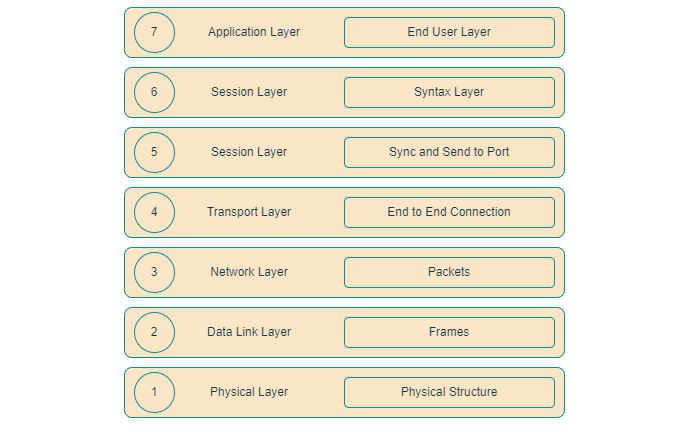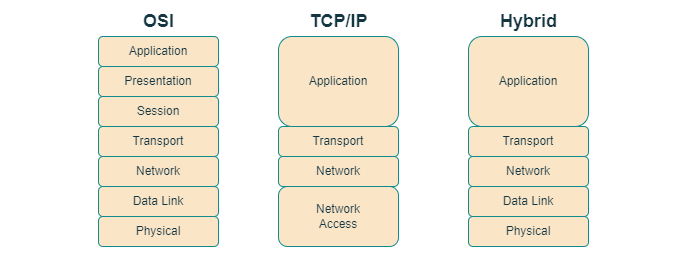
 Data Structure
Data Structure Networking
Networking RDBMS
RDBMS Operating System
Operating System Java
Java MS Excel
MS Excel iOS
iOS HTML
HTML CSS
CSS Android
Android Python
Python C Programming
C Programming C++
C++ C#
C# MongoDB
MongoDB MySQL
MySQL Javascript
Javascript PHP
PHP
- Selected Reading
- UPSC IAS Exams Notes
- Developer's Best Practices
- Questions and Answers
- Effective Resume Writing
- HR Interview Questions
- Computer Glossary
- Who is Who
OSI, TCP/IP and Hybrid Models in Computer Networks
Data communication is sharing information between devices over a network. Models and protocols enable it. Two common models are OSI and TCP/IP. We will explain them and the hybrid model, comparing their features, advantages and disadvantages.
The OSI Model
The OSI model stands for Open Systems Interconnection model. It was developed by the International Organization for Standardization (ISO) in 1984 as a reference model for network communication. The OSI model defines seven layers of network functions, from the physical layer that deals with the transmission medium to the application layer that interacts with the user. Each layer performs a specific task and communicates with the adjacent layers through interfaces.

Given below is a brief description of each layer:
Physical layer: This layer is responsible for transmitting and receiving raw bits over the physical medium, such as cables, wires or wireless signals. It defines the electrical, mechanical and procedural specifications of the network interface. Some of the protocols used in this layer are Ethernet, Wi-Fi, Bluetooth and USB.
Data link layer: This layer is responsible for providing error-free and reliable data transfer between two nodes on the same network. It defines the format of the data frames, the addressing scheme and the access control methods. It also performs error detection and correction, flow control and synchronization. Some of the protocols used in this layer are MAC, ARP, PPP and HDLC.
Network layer: This layer is responsible for routing data packets from one network to another across multiple intermediate devices, such as routers and switches. It defines the logical addressing scheme, such as IP addresses, and the routing algorithms, such as RIP and OSPF. It also performs fragmentation and reassembly, congestion control and quality of service. Some of the protocols used in this layer are IP, ICMP, IGMP and IPsec.
Transport layer: This layer is responsible for providing end-to-end data delivery between two applications on different hosts. It defines the transport protocol, such as TCP or UDP, and the port number that identifies the application. It also performs segmentation and reassembly, connection establishment and termination, error recovery and flow control. Some of the protocols used in this layer are TCP, UDP, SCTP and DCCP.
Session layer: This layer is responsible for establishing, maintaining and terminating sessions between two applications. It defines the session protocol, such as RPC or SQL, and the session identifier that distinguishes different sessions. It also performs authentication, authorization, synchronization and checkpointing. Some of the protocols used in this layer are NFS, SMB and NetBIOS.
Presentation layer: This layer is responsible for translating data between different formats and encoding schemes. It defines the syntax and semantics of the data exchanged between applications. It also performs encryption, decryption, compression and decompression. Some of the protocols used in this layer are SSL/TLS, JPEG and MPEG.
Application layer: This layer is responsible for providing user interface and application. Specific services to the user. It defines the application protocol, such as HTTP or FTP, and the message format that conveys information between applications. It also performs name resolution, directory services and email services. Some of the protocols used in this layer are HTTP, FTP, DNS and SMTP.
Advantages of the OSI Model
It provides a common basis for developing and coordinating standards for network communication.
It allows interoperability between different systems and vendors by defining common interfaces and protocols.
It facilitates modular design and implementation by separating network functions into independent layers.
It enables troubleshooting and testing by isolating problems at specific layers.
Disadvantages of the OSI Model
It is complex and abstract as it defines seven layers with many functions and protocols.
It is not fully compatible with some existing network technologies that do not follow its structure or principles.
It is not widely implemented as it is mainly used as a reference model rather than an operational model.
The TCP/IP Model
TCP/IP model stands for Transmission Control Protocol/Internet Protocol model. It was designed in the 1970s and used for Internet. TCP/IP model defines four layers of network functions. From network access layer that deals with physical medium to application layer that interacts with users. Each layer performs specific task and communicates with any other layer through sockets and ports.

The TCP/IP model has four layers:
Network access: Transmits data over physical medium (cables, wireless).
Internet: Routes data between networks using routers and switches.
Transport: Delivers data between applications on different hosts.
Application: Provides user interface and specific application services.
Advantages of the TCP/IP Model
It is simple and has only 4 layers.
It is compatible with most existing network technologies.
It is most used and implemented. Also , used for the Internet.
It has various routing protocols.
It has client-server architecture so supports distributed computing.
Disadvantages of the TCP/IP model
It is not much secure and can be attacked, e.g., SYN flooding, IP spoofing etc.
It does not guarantee delivery of packets by the transport layer.
It does not have a clear separation of functions between its layers.
The Hybrid Model
The hybrid model combines OSI and TCP/IP with five layers:
Physical: Sends raw bits over cables or wireless signals.
Data link: Provides error-free data transfer between nodes.
Network: Routes data across networks using routers and switches.
Transport: Ensures end-to-end data delivery between applications on hosts.
Application: Provides user interface and application services.
Advantages of Hybrid Model
It balances between simplicity and complexity.
It provides interoperability .
It enables flexibility and adaptability.
Disadvantages Hybrid Model
It may cause confusion and inconsistency by mixing different models with different structures and principles.
It may not support some advanced and specialized network functions that are not defined by either model.
It may not be fully compatible with some existing network technologies that do not follow its structure or principles.
Hybrid models are useful. Because it combines the benefits of both models. It provides framework for understanding and designing network systems. It has flexibility and compatibility for different network protocols and technologies.
Differences: OSI, TCP/IP and Hybrid Models
The following table highlights the different features of the three network models:
| OSI Model | TCP/IP Model | Hybrid Model |
|---|---|---|
| It has 7 layers: Physical, Data Link, Network, Transport, Session, Presentation and Application. | It has 4 layers: Application, Transport, Internet and Network Access. | It has 5 layers: Application, Transport, Network, Data Link and Physical. |
| It is a reference model that describes the functions of network communication. | It is an implemented model that defines the protocols for network communication. | It is a practical model that combines the features of both models. |
| It supports both connection-oriented and connectionless services. | It mainly supports connection-oriented services such as TCP. | It supports both connection-oriented and connectionless services. |
| It follows a vertical approach where each layer communicates with its adjacent layers. | It follows a horizontal approach where each layer communicates with its corresponding layer on another device. | It follows both vertical and horizontal approaches depending on the layer. |
| It is less reliable than the TCP/IP model. | It is more reliable than the OSI model. | It is as reliable as the TCP/IP model. |
Conclusion
Data communication is exchanging info between devices on a network. OSI and TCP/IP models define data formatting, transmission, and receiving.
OSI has seven layers: physical, data link, network, transport, session, presentation, application.
TCP/IP has layers: network access, internet, transport, application.
OSI provides standards but is complex. TCP/IP is simple and commonly used. Hybrid model combines OSI and TCP/IP, offering a balance between simplicity and complexity. It has five layers: physical, data link, network, transport, and application. Each model has strengths and weaknesses. Choice depends on network requirements.

